Vienna: The City of the Habsburgs and Art Nouveau
By Tracy A. Burns
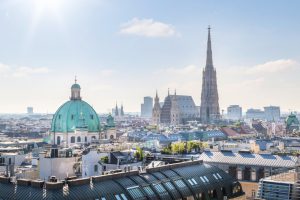 The 137-meter south tower and glazed roof tiles of Saint Stephen’s Cathedral dominate the Vienna skyline, and the city is filled with tributes to the Habsburg rulers, especially the 68-year reigning Emperor Franz Joseph. Habsburg’s history permeates the town. The breathtaking State Opera offers astounding performances, and visitors are awed by the opulence of Schönbrunn Palace and the Hofburg Palace, which is dotted with museums and imperial apartments. Austrian painters Gustav Klimt and Egon Schiele are household names here, and the Secession House pays a stirring tribute to the art nouveau. The plethora of museums includes the Upper Belvedere and Kunsthistorisches Museum, to name a few. Coffeehouses bustling with life appear at almost every corner.
The 137-meter south tower and glazed roof tiles of Saint Stephen’s Cathedral dominate the Vienna skyline, and the city is filled with tributes to the Habsburg rulers, especially the 68-year reigning Emperor Franz Joseph. Habsburg’s history permeates the town. The breathtaking State Opera offers astounding performances, and visitors are awed by the opulence of Schönbrunn Palace and the Hofburg Palace, which is dotted with museums and imperial apartments. Austrian painters Gustav Klimt and Egon Schiele are household names here, and the Secession House pays a stirring tribute to the art nouveau. The plethora of museums includes the Upper Belvedere and Kunsthistorisches Museum, to name a few. Coffeehouses bustling with life appear at almost every corner.
Saint Stephen’s Cathedral
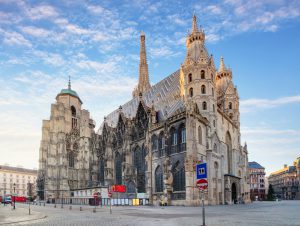 Dating back to the Romanesque era, the most famous Viennese landmark marks the cityscape with its 137-meter high south tower and 230,000 colorful glazed roof tiles. When it caught fire in April of 1945, about 45 percent of the architectural gem was destroyed but fortunately rebuilt. On the exterior gargoyles spew water, defending the city against demons. Inside the high altar is the first and most prominent Early Baroque altar in the city.
Dating back to the Romanesque era, the most famous Viennese landmark marks the cityscape with its 137-meter high south tower and 230,000 colorful glazed roof tiles. When it caught fire in April of 1945, about 45 percent of the architectural gem was destroyed but fortunately rebuilt. On the exterior gargoyles spew water, defending the city against demons. Inside the high altar is the first and most prominent Early Baroque altar in the city.
The pulpit and more cathedral attractions
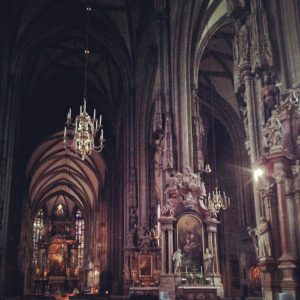 The pulpit, hailing from the late 15th century, is astounding for its Renaissance sculptural ornamentation. Four church doctors peer out from what looks like stone windows in the pulpit, symbolizing the four ages of man and the four temperaments. Be sure to gaze under the steps: A self-portrait of the unknown sculptor peeks out at the viewer. Stone snakes and lizards as well as three-leafed and four-leafed wheels decorate the banister. Baroque choir stalls adorn the nave. The four-winged Wiener Neustadt Altar from 1447 is enthralling, illustrating scenes from Mary’s life. Burial vaults under the building house the brains, eyes, and intestines of 72 Habsburg rulers.
The pulpit, hailing from the late 15th century, is astounding for its Renaissance sculptural ornamentation. Four church doctors peer out from what looks like stone windows in the pulpit, symbolizing the four ages of man and the four temperaments. Be sure to gaze under the steps: A self-portrait of the unknown sculptor peeks out at the viewer. Stone snakes and lizards as well as three-leafed and four-leafed wheels decorate the banister. Baroque choir stalls adorn the nave. The four-winged Wiener Neustadt Altar from 1447 is enthralling, illustrating scenes from Mary’s life. Burial vaults under the building house the brains, eyes, and intestines of 72 Habsburg rulers.
The State Opera
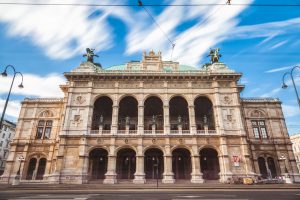 The elegant State Opera opened in 1869 but was bombed in 1945. It took 10 years for the makeover. On the exterior, a loggia façade with statues of muses on horseback enthralls. A triumphal arch is set prominently in front of the main roof. Above it is a shield flanked by eagles with the so familiar Habsburg-Lothringen coat-of-arms, and on the top is the Austrian imperial crown.
The elegant State Opera opened in 1869 but was bombed in 1945. It took 10 years for the makeover. On the exterior, a loggia façade with statues of muses on horseback enthralls. A triumphal arch is set prominently in front of the main roof. Above it is a shield flanked by eagles with the so familiar Habsburg-Lothringen coat-of-arms, and on the top is the Austrian imperial crown.
The dazzling interior
The interior is even more fascinating. The main staircase shows off seven allegorical statues, representing arts such as music, dance, and sculpture. Twenty-two-carat gold leaf décor adorns the building. The Gustav Mahler intermission room is decorated with 14 paintings of famous operas and busts of composers as well as 13 tapestries of The Magic Flute. The crystal chandelier in the auditorium weighs 12 tons. The stage is twice as large as the auditorium. Some 2,200 people can watch a performance.
Schönbrunn Palace
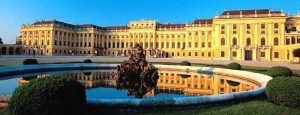 Proclaimed as a UNESCO World Heritage site in 1996, Schönbrunn Palace with its yellow façade boasts state rooms and private apartments on the piano nobile, splendid monument-filled parks, and a zoo. The glory days of Empress Maria Theresa’s reign were lived out here, and this is where Emperor Franz Joseph was born and died. American President John F. Kennedy even met with Soviet Premier Nikita Khrushchev in a stunning hall at the palace. The Great Gallery, once used for balls and banquets, is a highlight of the tour. The ornamentation is lavish. White and gold stucco decor, tall crystal glass mirrors, and ceiling frescoes dating from the mid-18th century shout Rococo. The East Asian Cabinets are spectacular, too, yet intimate. Chinoiserie furniture, silk wall hangings, and Japanese and Chinese porcelain adorn the space. White paneling and gilded rocaille décor appear on the walls. Chinese lacquer panels show landscapes, flowers, and birds. Rococo chandeliers round out the beauty of this space. And these are only two of the 40 rooms on the tour. Online tickets can be purchased at www.schoenbrunn.at.
Proclaimed as a UNESCO World Heritage site in 1996, Schönbrunn Palace with its yellow façade boasts state rooms and private apartments on the piano nobile, splendid monument-filled parks, and a zoo. The glory days of Empress Maria Theresa’s reign were lived out here, and this is where Emperor Franz Joseph was born and died. American President John F. Kennedy even met with Soviet Premier Nikita Khrushchev in a stunning hall at the palace. The Great Gallery, once used for balls and banquets, is a highlight of the tour. The ornamentation is lavish. White and gold stucco decor, tall crystal glass mirrors, and ceiling frescoes dating from the mid-18th century shout Rococo. The East Asian Cabinets are spectacular, too, yet intimate. Chinoiserie furniture, silk wall hangings, and Japanese and Chinese porcelain adorn the space. White paneling and gilded rocaille décor appear on the walls. Chinese lacquer panels show landscapes, flowers, and birds. Rococo chandeliers round out the beauty of this space. And these are only two of the 40 rooms on the tour. Online tickets can be purchased at www.schoenbrunn.at.
The Hofburg Palace
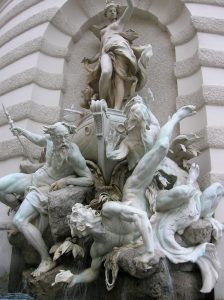 This large complex of palaces used to be home to Habsburg emperors. Now it houses the elegant imperial apartments, the Spanish Riding School, and the Sisi Museum dedicated to Empress Elizabeth, Emperor Franz Joseph’s wife who was assassinated in 1898. The New Palace museums show off weaponry and musical instruments. A visit to the Imperial Apartments is a must. In the waiting room of the Emperor’s rooms, there is a remarkable Baroque crystal chandelier. Trompe l’oeil paintings grace the Emperor’s study. The Emperor’s bedroom stands out because it is so spartan. The Empress’ Great Salon is decorated with Mediterranean landscapes. The Treasury is also not to be missed. The personal crown of Emperor Rudolf II and the 10th century crown of the Holy Roman Emperor are on display. Religious objects, reliquaries, vestments, and regalia also make up the exposition. In addition, there is a 2,680-karat emerald, the Holy Lance dating from 750 to 800 AD, and the Imperial Cross, created in 1030.
This large complex of palaces used to be home to Habsburg emperors. Now it houses the elegant imperial apartments, the Spanish Riding School, and the Sisi Museum dedicated to Empress Elizabeth, Emperor Franz Joseph’s wife who was assassinated in 1898. The New Palace museums show off weaponry and musical instruments. A visit to the Imperial Apartments is a must. In the waiting room of the Emperor’s rooms, there is a remarkable Baroque crystal chandelier. Trompe l’oeil paintings grace the Emperor’s study. The Emperor’s bedroom stands out because it is so spartan. The Empress’ Great Salon is decorated with Mediterranean landscapes. The Treasury is also not to be missed. The personal crown of Emperor Rudolf II and the 10th century crown of the Holy Roman Emperor are on display. Religious objects, reliquaries, vestments, and regalia also make up the exposition. In addition, there is a 2,680-karat emerald, the Holy Lance dating from 750 to 800 AD, and the Imperial Cross, created in 1030.
Secession House
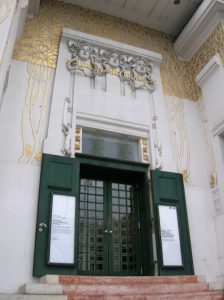 Established in 1897 by a group of artists guided by Gustav Klimt, the Secession organization devoted itself to Modernism. This pavilion-like example of art nouveau architecture opened in 1898, hosting the Second Exhibition of Secession, which triggered harsh criticism. Crowned with a gilded dome and conceived as an “art temple,” the Secession House boasts a façade decorated with the words, “To the age its art. To art its freedom.” The entrance is decorated with gilded friezes of foliage. Three female busts representing painting, sculpture, and architecture make appearances, too. Inside, there are temporary exhibitions, but the highlight is Klimt’s Beethoven frieze, created for the XIVth exhibition of the Association of Visual Artists – Vienna Secession in 1902 and considered one of the premiere examples of Viennese Art Nouveau. Inspired by Richard Wagner’s interpretation of Beethoven’s Ninth Symphony, the frieze exhibits humankind’s quest for happiness. Notice the snakes slivering in the Gorgon’s hair and the glittering gold armor of the knight.
Established in 1897 by a group of artists guided by Gustav Klimt, the Secession organization devoted itself to Modernism. This pavilion-like example of art nouveau architecture opened in 1898, hosting the Second Exhibition of Secession, which triggered harsh criticism. Crowned with a gilded dome and conceived as an “art temple,” the Secession House boasts a façade decorated with the words, “To the age its art. To art its freedom.” The entrance is decorated with gilded friezes of foliage. Three female busts representing painting, sculpture, and architecture make appearances, too. Inside, there are temporary exhibitions, but the highlight is Klimt’s Beethoven frieze, created for the XIVth exhibition of the Association of Visual Artists – Vienna Secession in 1902 and considered one of the premiere examples of Viennese Art Nouveau. Inspired by Richard Wagner’s interpretation of Beethoven’s Ninth Symphony, the frieze exhibits humankind’s quest for happiness. Notice the snakes slivering in the Gorgon’s hair and the glittering gold armor of the knight.
Belvedere Palace
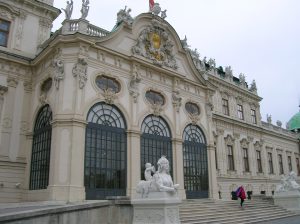 The Belvedere Palace includes the Lower Belvedere (1714) and the Upper Belvedere (1720-21), connected by an elegant garden. While the Lower Belvedere boasts lavishly decorated residential rooms, the Upper Belvedere is the focus of any visit as it is home to masterful works of art. The Kiss and numerous other paintings by Klimt are on display. Egon Schiele’s creations enthrall as well. Some works even drew inspiration from Prague. For instance, Oskar Kokoschka’s Prague Harbor is a mesh of brilliant colors showing Saint Vitus Cathedral, Petřín Tower, the Charles Bridge, and other landmarks. Max Oppenheimer’s The Philharmonic, created from 1926 to 1952, swirls with brass and string instruments as well as glistening trumpets. The grotesque and unsettling busts by Franz Xaver Messerschmidt should not be overlooked, either. Tickets can be purchased online at www.belvedere.at.
The Belvedere Palace includes the Lower Belvedere (1714) and the Upper Belvedere (1720-21), connected by an elegant garden. While the Lower Belvedere boasts lavishly decorated residential rooms, the Upper Belvedere is the focus of any visit as it is home to masterful works of art. The Kiss and numerous other paintings by Klimt are on display. Egon Schiele’s creations enthrall as well. Some works even drew inspiration from Prague. For instance, Oskar Kokoschka’s Prague Harbor is a mesh of brilliant colors showing Saint Vitus Cathedral, Petřín Tower, the Charles Bridge, and other landmarks. Max Oppenheimer’s The Philharmonic, created from 1926 to 1952, swirls with brass and string instruments as well as glistening trumpets. The grotesque and unsettling busts by Franz Xaver Messerschmidt should not be overlooked, either. Tickets can be purchased online at www.belvedere.at.
Other museums
The Kunsthistorisches Museum presents the art collection amassed by Habsburg leaders. Flemish Renaissance painter Pieter Bruegel the Elder, the 16th century master of scenes from village life, is a star performer here. Many of his creations, including The Peasant Wedding, Peasant Dance, and Hunters in Snow adorn these walls. Venetian Renaissance artists are well-represented, too, with Titian, Tintoretto, and Paolo Veronese getting the most attention while Raphael, Correggio, and Giuseppe Arcimboldo dominate the Italian Renaissance and Mannerism. Caravaggio, Peter Paul Rubens, Johannes Vermeer, Albrecht Dürer and Rembrandt van Rijn are by no means forgotten, either. But this is only one of a plethora of museums in Vienna. The Albertina, adjacent to the Hofburg, hosts tremendous, extensive temporary exhibitions and houses a permanent exhibition called “From Monet to Picasso,” featuring works of Modernism and contemporary art by artists such as Marc Chagall, Wassily Kandinsky, and Paul Klee. The Leopold Museum is well-known for the world’s largest collection of paintings by Schiele and an extensive collection of works by Klimt.
Coffeehouses and the Café Griensteidl
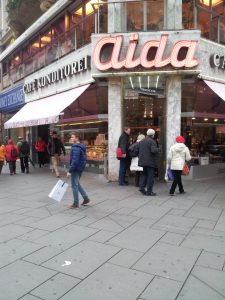 No visit to Vienna is complete without lingering in a coffeehouse where customers devour rich desserts or study the day’s paper. Located across from the main entrance to the Hofburg Palace, the Griensteidl was Vienna’s first legendary coffeehouse, opening in 1847. Imagine sitting there in the 1890s, surrounded by all those young Viennese writers, such as Peter Altenberg, Hugo von Hofmannsthal, and Arthur Schnitzler. The coffeehouse was torn down in 1897, and cafegoers paid tribute by eating an extraordinary funeral meal. The current café was opened in 1990. Food is offered, too.
No visit to Vienna is complete without lingering in a coffeehouse where customers devour rich desserts or study the day’s paper. Located across from the main entrance to the Hofburg Palace, the Griensteidl was Vienna’s first legendary coffeehouse, opening in 1847. Imagine sitting there in the 1890s, surrounded by all those young Viennese writers, such as Peter Altenberg, Hugo von Hofmannsthal, and Arthur Schnitzler. The coffeehouse was torn down in 1897, and cafegoers paid tribute by eating an extraordinary funeral meal. The current café was opened in 1990. Food is offered, too.
Other possibilities
There are numerous ways to enjoy time in this magnificent city. Take a stroll on Kohlmarkt, Vienna’s most luxurious street. Feel the history of the Graben with its plague column. Visit the enthralling Baroque masterpiece, Saint Peter’s Church. Pay your respects to Habsburg leaders in the Imperial Crypt. Taste the delicious chocolate cake in the Café Sacher. Admire the French Rococo style “Golden Carriage” in the Liechtenstein Museum. Take a look at the colorful and playful exterior of the Hundertwasser apartments. Whatever you choose to see, you can’t go wrong in this extraordinary city with so many sights that tell so many amazing stories.




